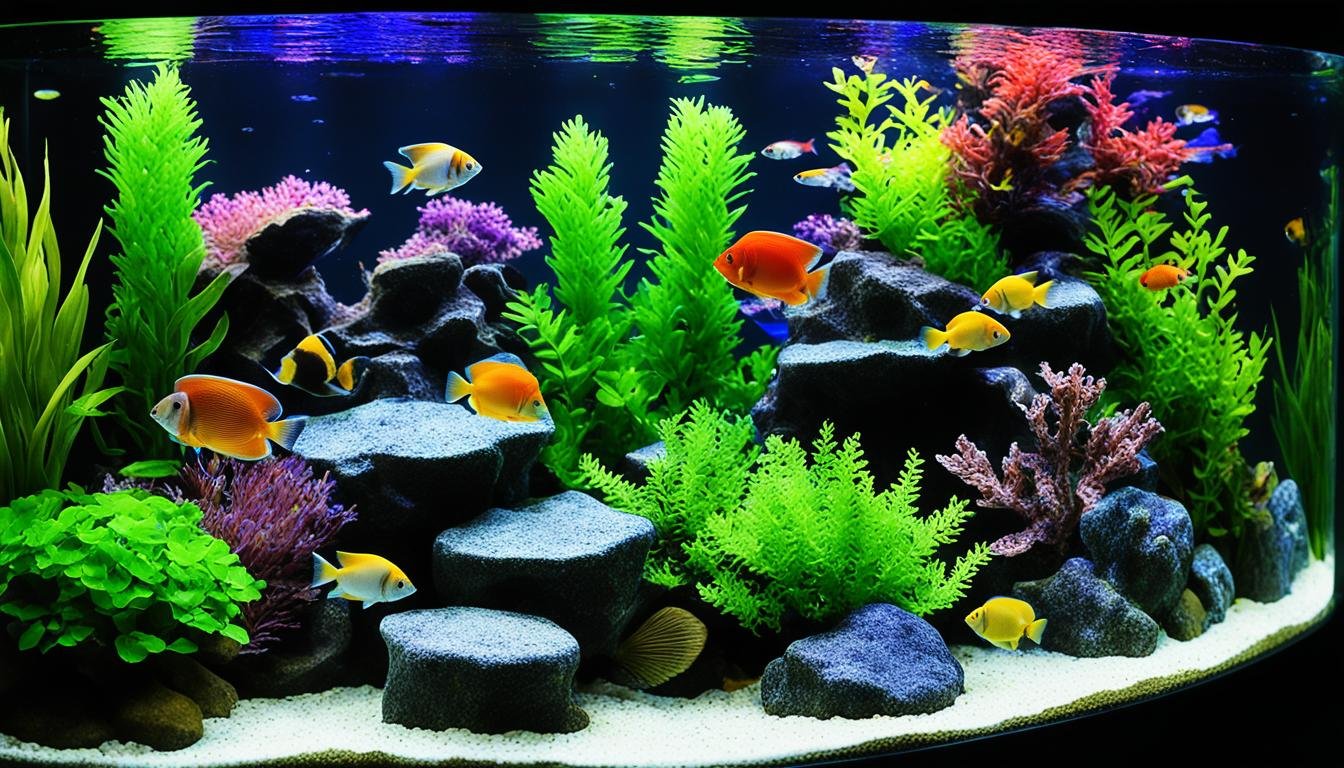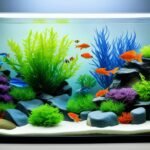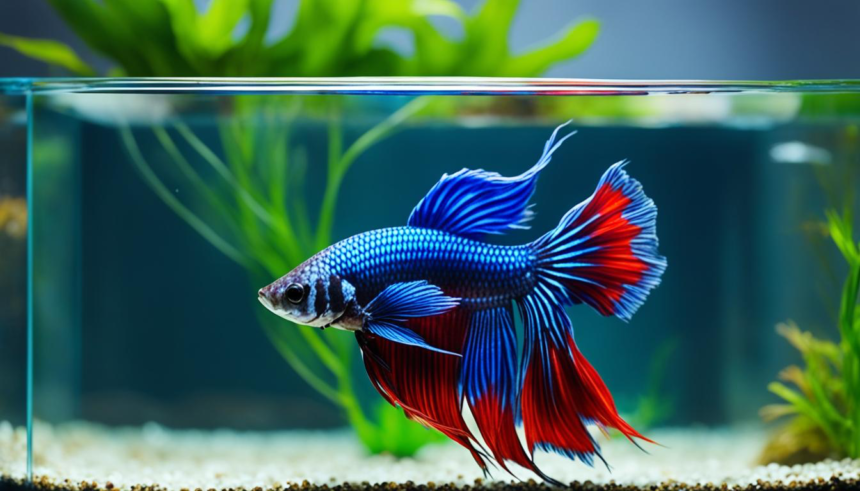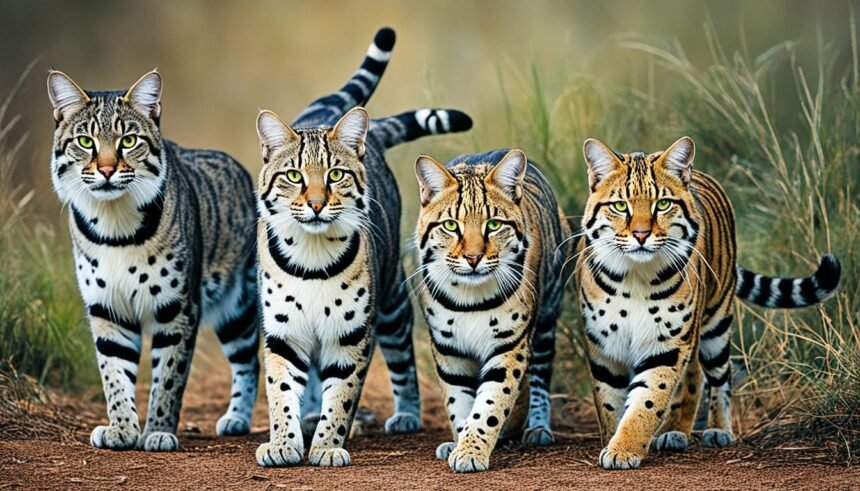Step into a world where ornamental fish bring color and life to aquariums. From the swift Siamese Algae Eater, growing up to 6 inches, to the shiny Congo Tetra at 3 inches, they welcome us into a diverse space. These fish are more than pets; they’re swimming artwork that adds beauty and calm.
Awell-kept aquarium, like a 55-gallon tank for the Leopard Bush Fish, offers more than looks. The Sunset Variatus Platy thrives in smaller, 20-gallon tanks, while the Silver Hatchetfish needs a secure space to prevent jumping. They show how life and its surroundings rely on each other.
Keeping ornamental fish means understanding their needs, from the large Elephant Nose Fish to social Cherry Shrimp and Rummy-Nose Tetras. Our aquariums are tiny worlds. As keepers, we act like conservationists, mixing species like Rosy Barbs and Corydoras Catfish for a balanced ecosystem.
The beauty of these fish in aquariums tells a wider story about trade, conservation, and culture. The desire for Clownfish skyrocketed after ‘Finding Nemo’. These creatures’ lives are tied to our preferences, trades, and environmental efforts globally, from Florida to Indonesia. Join this journey of discovery and care, one fish tank at a time.
Introduction to Ornamental Fish In Your Home Aquaspace
Inviting ornamental fish into your home aquaspace is like creating a living art piece. The world of aquarium fish is wide and colorful. It has species that range from bright tropical fish to elegant freshwater ones. Starting a fishery at home is more than loving the beauty. It means learning the culture and biology that keep these creatures going.
Getting into the world of ornamental fish is not just about setting up a tank. You’re creating an entire ecosystem. You need to think about what your fish need, like water pH and temperature. Different fish need different things, just like plants in a garden.
Taking care of fish at home means being ready for everything. This includes knowing about breeding, like raising baby brine shrimp. It also means understanding that some snails, like ramshorn, do better in their own tank with certain water.
| Culture Type | Requirements | Species Benefit |
|---|---|---|
| Baby Brine Shrimp | Soak in salt water, 18-36 hours at 74–82°F (23–28°C) | Ideal for small to medium tropical fish fry |
| Snails Breeding | Separate hard water aquarium, higher pH | Bladder, Ramshorn, Malaysian Trumpet Snails |
| Vinegar Eels Culturing | 50% apple cider vinegar, 50% dechlorinated water, apple slices | Microscopic live food for smallest fry |
| Daphnia | Stable water parameters, sensitive to chlorine | Feeding small to medium freshwater fish |
| Infusoria Cultures | Mulm, old tank water, food like banana peel or yeast | Nutrition for the tiniest of fish fry |
| Blackworms | Rinsed in dechlorinated water, stored chilled at 40–55°F (4–13°C) | Suitable for bottom dwellers and larger fry |
Ornamental fish diets vary a lot. Some fish eat live foods like Daphnia, others like different insects or fish. A good diet keeps fish strong and prevents disease. This is true for guppies, bettas, cichlids, and catfish.
Recently, the fishery industry has been working on being more sustainable. Groups like OATA help make sure fish and their environments are healthy. They work with experts to keep our aquatic hobbies safe and responsible.
- New rules are in place for bringing live fish and plants into the UK. This helps with biosecurity and conservation.
- OATA is also teaching local inspectors to make sure pet shops and breeders are doing their best.
- And, during water shortages, fish pond owners get some leeway. This shows how important aquatic life is to local water groups.
Starting with ornamental aquarium fish opens up a whole new world. Whether it’s a freshwater setup or a tropical tank, your home becomes a space filled with wonder. It shows just how joyful and interesting keeping fish can be.
Creating a Freshwater Community Aquarium

Starting a freshwater community aquarium is more than just adding water and fish. It’s a delicate ecosystem that needs careful planning. You can mix various colorful freshwater fish. But, getting this right means paying close attention to their needs.
Essentials of a Balanced Freshwater Habitat
Creating a natural habitat for different fish starts with the right substrate, like sand or gravel. Aquarists add plants, rocks, driftwood, and sculptures for aesthetics and to help the fish feel at home.
The water temperature is vital too. Most fish love warm water between 75 and 86 °F. However, coldwater fish, like goldfish, don’t need a heater. It’s crucial not to mix these fish types. A well-balanced tank also needs filters, heaters, thermometers, air pumps, and lights.
Choosing Fish That Thrive Together
When picking fish, consider their behavior and what they eat to avoid fights. Choose peaceful fish of similar sizes to keep peace in the tank. Guppies are great for their calm nature and ease of care.
Water quality is also key. Fish do best in a pH of 6 to 8. The nitrogen cycle helps turn waste into safe compounds. This cycle works best with good filtration, regular water changes, and sometimes live plants.
Popular Community Fish Species
Freshwater community tanks showcase a variety of fish. Choosing the right mix makes for a stunning aquarium.
| Common Community Fish | Compatibility | Special Requirements |
|---|---|---|
| Mollies | Non-aggressive | Prefer slightly brackish water |
| Guppies | Peaceful | Enjoy densely planted tanks |
| Tetras | Schooling fish | Need ample swimming space |
| Swordtails | Active | Require varied diet |
This list includes peaceful fish that add uniqueness to the tank. They live well together without causing trouble.
A community aquarium’s beauty comes from its variety of fish and the challenge of keeping them all healthy. Seeing these different lives thrive together is what makes aquarium keeping rewarding.
Understanding Aggression in the Aquarium: Aggressive Fish
Understanding the behavior of fish is key when setting up aquariums. Aggressive fish like the Siamese fighting fish require special care. These species need big tanks and a well-planned environment to control their aggression.
Setting Up a Sanctuary for Larger Specimens
Choosing a big tank is the first step for housing large, aggressive fish. These species, including Coho salmon, need space and structures like plants. This helps in managing territorial behaviors and providing hiding spots.
Species That Demand Dominance: A Closer Look
Aggression in fish is often about competing for resources. Species with high aggression levels, like Oscars, need careful planning. Studies show environment and hormones affect aggression, as seen in Julidochromis ornatus.
Finding the right tank mates for aggressive fish is crucial. They need more space to reduce stress and avoid fights. Understanding their past behaviors helps create a stable community in the aquarium.
Learning about fish aggression is important for aquarists of all levels. By considering the needs of aggressive species, aquarists can create a peaceful tank environment.
Types of Ornamental Fish: A Dive Into Species and Varieties

In the colorful world of aquariums, angelfish are truly special. They stand out with their grand fins and bright colors. They are key players in the fish trade. The Queen Angelfish and Blue Angelfish are great examples. They can grow up to 45 cm, showing how amazing and diverse this genus is.
Not all angelfish are so big, though. The Gray Angelfish can get even bigger, reaching 60 cm. But on the smaller side, we have the Flame Angelfish and Coral Beauty Angelfish. They only grow to about 15 cm and 10 cm. Along with the tiny Cherubfish, which reaches just 8 cm, they’re seen as ‘reef safe with caution’. This is key for those in the labyrinth fish community wanting a peaceful aquarium.
- The Queen Angelfish max size: 45 cm
- The Blue Angelfish max size: 45 cm
- The Gray Angelfish max size: 60 cm
- The Flame Angelfish max size: 15 cm & reef safe
- Coral Beauty Angelfish max size: 10 cm & reef safe with caution
- Cherubfish (Pygmy Angelfish) max size: 8 cm & reef safe with caution
Moving past angelfish, let’s look at Anthias. They bring color and vibrancy to any tank. Squareback Anthias, Bartlett’s Anthias, and Lyretail Anthias, also called Sea Goldie, are all about 15 cm. They’re known to be reef safe. Bicolor Anthias are similar to Bartlett’s but a bit larger at 13 cm. They add to the beauty of seas around the world.
- Squareback Anthias (Fairy Basslets) max size: 15 cm & reef safe
- Bartlett’s Anthias max size: 9 cm & reef safe
- Lyretail Anthias (Sea Goldie) max size: 15 cm & reef safe
- Bicolor Anthias max size: 13 cm
Looking at fish, we see a mix of size, habitat fit, and need for preservation. This creates a rich scene for both new and expert aquarists. The fish trade keeps providing many species. By choosing wisely, aquarists can keep their tanks healthy and enjoy their hobby.
The Solo Fish Aquarium: Species That Prefer Solitude
Choosing fish for your aquarium needs careful thought about how they live and what they need. Some fish do well on their own and setting up a tank for them is both a challenge and rewarding. Solo fish tanks are great for large or aggressive fish that prefer being alone.
Big fish like the Oscar or Pacu need more space and special care. This is easier in a tank for just one fish. Aggressive fish also do better alone. This stops fights and keeps them healthy. Solo tanks make a calm home for these fish, making them feel like they’re in the wild.
- Goldfish need big tanks because they make the water dirty quickly. One goldfish can live long and get big if the tank is clean.
- Pacus look like Piranhas but need to live alone because they get very big. They need a lot of room, so they’re not good with other fish.
- Big catfish need certain types of ground and places to hide. A tank for just one catfish helps avoid fights and keeps them happy.
Think about what a single fish needs before setting up a solo tank. Things like which plants they like, the type of ground, and what they eat matter. A well-made solo tank is not just beautiful but shows you care about your fish’s health and happiness.
The Role of Sri Lanka in the Ornamental Fish Industry
Sri Lanka is a big player in the ornamental fish trade. It’s known for its wide range of fish, which are raised in a way that’s good for the planet. These fish are sent to aquariums all over the world.
Exporting Exotic Varieties to Global Markets
Sri Lanka sends beautiful and unique fish to about 25 countries. The demand for these eye-catching creatures drives this trade. One of the stars is the fancy guppy, making up 65% of freshwater fish exports.
The country has seen its ornamental fish exports grow by 7.2% each year in value. In 2019, Sri Lanka’s fish reached 76 countries. Most of its trade goes to just 11 countries, showing strong trade ties.
Sustainable Breeding and Conservation Efforts
Sri Lanka is not just focused on breeding fish; it also cares about nature. From 1994 to 1999, the BOBP worked on saving fish species and keeping their populations healthy. This work helps manage fish trade in seven countries.
In Sri Lanka, fish farming is done with nature in mind. This helps keep fish populations healthy for trade. It’s important to know about these fish to trade them without harming nature.
| Freshwater Ornamental Exports | Marine Ornamental Exports | Conservation and Management Visibility |
|---|---|---|
| 70% of Total Exports | 30% of Total Exports | High, with a focus on endangered species |
| Main Export: Fancy Guppies | Trade involves over 125 countries | Sustainable Management Practices in Place |
| 65% of Freshwater Export Volume | Steady Trade Growth | BOBP Efforts: 1994 – 1999 |
Sri Lanka keeps improving its fish trade with nature in mind. It aims to send top-quality fish to markets worldwide.
Fancy Guppies: The Colorful Pride of Freshwater Aquariums
Guppies are special in freshwater aquariums worldwide. They are not only popular but also boost the aquarium fish market’s success.
Guppies have won over hearts with their colors and easy care. They are loved by both new and expert aquarium owners. Their popularity shines through in the fish export markets of top aquatic life countries.
The Global Popularity of Guppies
In Sri Lanka, guppies are a big deal, making up nearly 60-70% of fish exports. As a top guppy and ornamental fish exporter, the country fulfills more than 4% of the world’s need. This shows how much the world loves guppies.
They are easy to adapt and breed, making them favorites in many countries. This includes the USA, the UK, EU regions, and parts of Asia. Their widespread presence in home aquariums speaks to their popularity. It helps with fish health awareness and brings more people into the hobby.
Breeding Standards and Health Certification
Sri Lanka’s guppy exports thrive because of strict breeding quality standards. This ethical approach ensures the fish live healthily after they are moved. Health certifications play a key role, setting a standard that builds trust in the market.
A health certificate comes with every fish shipment. It shows the fish meet high quality and health standards. This assures buyers their new fancy guppies are healthy, well-bred, and free from common diseases.
Keeping high standards is crucial for Sri Lanka’s role in the global market. It ensures ongoing demand for high-quality guppies. These guppies not only look beautiful but are also strong. They win over people everywhere, making them a popular choice for aquariums.
Marine Beauties: Exploring Saltwater Ornamental Fish

The marine aquarium trade is more than just common fish. Bright marine fishes draw hobbyists to build ocean beauty at home. They face challenges like managing water and nurturing aquatic plants. Yet, they also experience the joy of watching aquatic vegetation grow.
Challenges and Rewards of a Marine Aquarium
Running a marine aquarium is fulfilling but complex. You must understand the ecosystem. Tasks include testing water, setting the right light for corals from Florida, and following feeding schedules. Normal Aquatics helps by offering free advice.
Starting with marine ornamental fish usually means choosing beauties like Mandarinfish or Flame Angelfish. These fish, along with peaceful Giant Clams, create a stunning underwater scene. Yet, caring for them is complex due to their specific needs, like special water quality and lighting, especially for Acropora Corals.
Rare Marine Species in the Aquarium Trade
In the aquarium trade, advances in intensive culture have brought new species. This has increased the demand for rare marine creatures. Researchers focus on species like Cinnamon clownfish, exploring how to breed them sustainably. Rules now protect endangered species like Venus Sea Fans, so hobbyists must stay informed.
Breeding efforts have grown, especially in Florida for rare species like Ptereleotris zebra. But, achieving sustainable breeding is hard and costly. The goal is to balance conservation with commerce.
The marine aquarium trade is moving towards an eco-friendly approach. Research and new techniques aim to satisfy the market while protecting nature. This shift promises a better future for both our tanks and the environment.
Conclusion
Our journey through the aquarium hobby ends with a meaningful understanding. We see the beauty and diversity of ornamental fish. We also learn about their economic impact. In 2018, the U.S. made $41.3 million from ornamental fish aquaculture. With Florida at the helm, it’s clear this is more than just a hobby; it significantly adds to the agriculture sector.
The University of Florida and the Tropical Aquaculture Laboratory lead in research and innovation. They push the marine ornamental fish farming industry forward. Though small compared to fresh-water fish farming, marine fish farming has grown to include 398 species. However, caring for marine ecosystems is complex. Aquarium owners often rely on catching fish from the wild. This highlights the importance of sustainability in the trade.
Aquarium lovers contribute to both the aquatic environment and global rural development. The ornamental fish industry is compelling and changes like the waters these fish call home. As we reflect on ornamental fishkeeping, we realize its wide impact. From a vibrant goby in a home aquarium to the marine fish farmed in Florida, this hobby unites aquarium enthusiasts worldwide. It blends the joy of keeping fish with the intricate science behind it.
FAQ
What are some popular types of ornamental fish for aquariums?
Guppies, tetras, angelfish, mollies, and cichlids are popular for aquariums. They make the aquarium look more beautiful with their unique looks and actions.
What do I need to know before adding ornamental fish to my home aquarium?
Before you add fish to your aquarium, learn about their needs. This includes tank size, water conditions, and what they eat. Also, know how they get along with others to keep your aquarium happy.
What are the essentials of setting up a balanced freshwater community aquarium?
For a balanced aquarium, keep the water’s pH, hardness, and temperature right for the fish. You also need a tank that’s 20 to 50 gallons to fit all the fish safely.
How do I select compatible fish species for a community aquarium?
To pick the right fish, look at their temperament, size, and what they eat. Choose peaceful fish that like the same water and food for a happy tank.
What are some popular community fish species?
Neon tetras, swordtails, platys, rasboras, and gouramis are great for community tanks. They’re peaceful and good at living together.
How do you design an aquarium for aggressive or larger fish species?
An aquarium for big or aggressive fish needs a lot of space, at least 75 gallons. Include places for them to hide. Only put together fish that are okay with the environment and are strong enough to be together.
Can you provide examples of species that dominate their tank environments?
Oscars, Jack Dempseys, and Red devil cichlids are examples. They’re territorial and might need a tank by themselves or with fish that can handle them.
What factors categorize the vast array of ornamental fish species in the aquarium trade?
Fish in the trade are sorted by size, color, where they like to live, and how easy they are to take care of. They’re also organized by their family and species, showing their natural relationships.
What species are suitable for a solo fish aquarium?
Goldfish, Oscars, and Arowanas do well on their own. They don’t have to share food or space, making them happy alone.
How significant is Sri Lanka in the ornamental fish industry?
Sri Lanka is key in the fish industry because of its variety of fish and big exports. The country focuses on breeding fish the right way and helping conserve them while meeting global needs.
What are the standout traits of fancy guppies in the freshwater ornamental fish segment?
Fancy guppies stand out because of their bright colors and patterns. They’re easy to breed for special looks and are tough, making them loved by fish fans.
How do Sri Lankan breeders ensure the health and quality of their guppies?
Sri Lankan breeders use strict standards in genetics and care to make sure their guppies are healthy. They also have health checks for guppies going to other countries, matching global quality standards.
What are the unique considerations for maintaining a saltwater aquarium?
Saltwater tanks need more care than freshwater ones. They must have the right salt level, temperature, and pH. The sea creatures also need special food and care.
What makes rare marine species in the aquarium trade so appealing?
Rare sea creatures draw in fans with their special looks and colors. They turn an aquarium into a lively and interesting water world, making them very sought after for home tanks.













